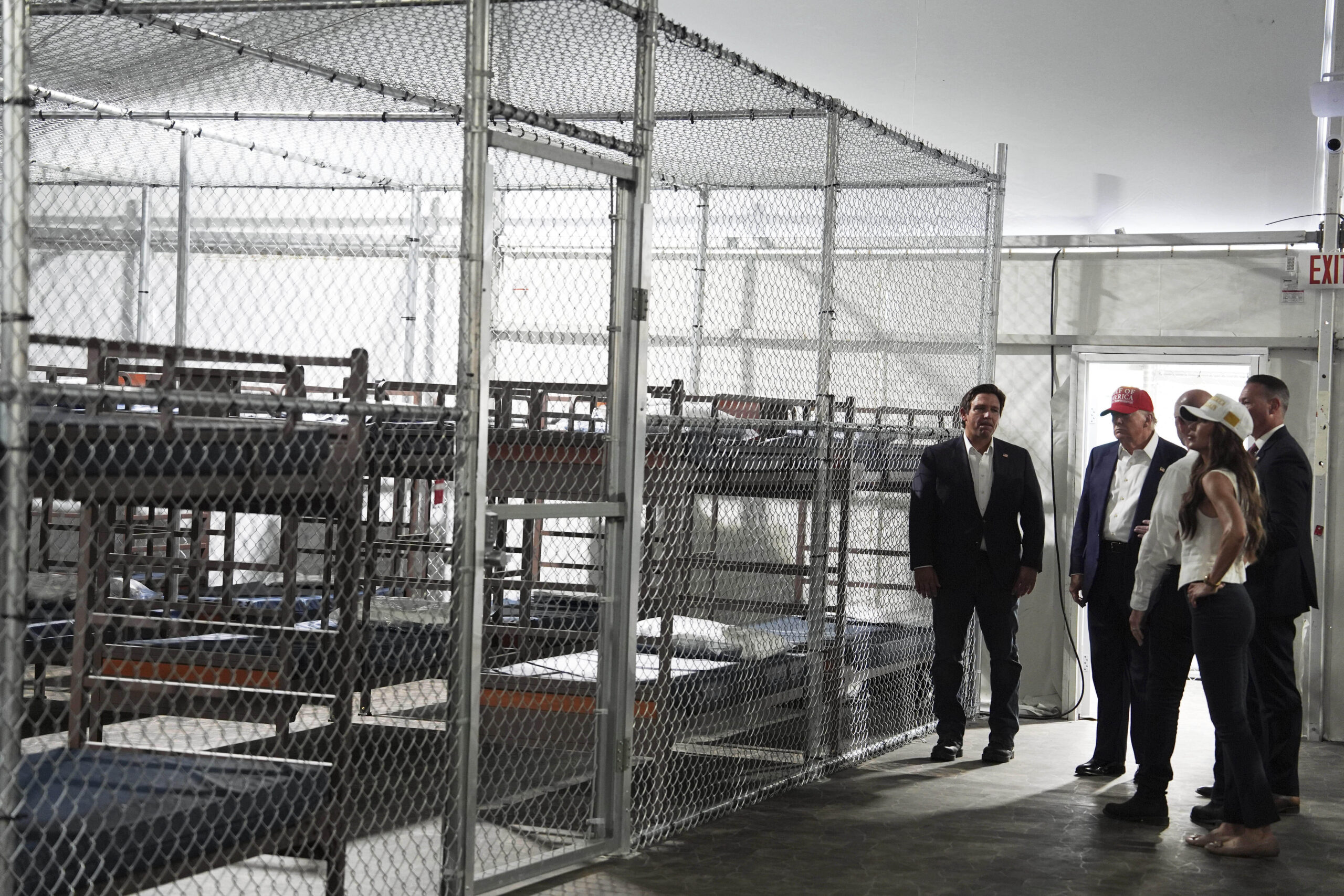BOYNTON BEACH, Fla. — Black America has its very own Auschwitz.
It’s called “Alligator Alcatraz,” a hastily put together collection of tent-covered cages and trailers on an abandoned airstrip in the Florida Everglades. The name, in part, derives from its California namesake, a notorious island prison off of San Francisco. Unlike the original Alcatraz, this prison is surrounded by miles of swampland that is home to alligators and pythons, and this newer version comes with the racial baggage of a dark period of America’s past.
Since its opening in early July, detainees have complained of tainted, inedible food, lack of medical care, and inhumane living conditions in the mosquito-infested facility. Those detainees fortunate enough to have legal representation don’t have easy access to their lawyers because camp officials initially refused to allow the lawyers inside, citing technology issues. Florida Gov. Ron DeSantis and other members of his administration have denied allegations of mistreatment.

The facility, however, did turn away elected officials — primarily Democrats — who were concerned about the camp’s conditions and have the legal authority to make unannounced visits as part of their oversight responsibilities. Alligator Alcatraz officials ultimately invited Republican and Democratic elected officials to tour the facility.
Critics called the tour “sanitized.”
“What’s happening at the [Alligator Alcatraz] detention center isn’t just an immigration story,” state Sen. Shevrin Jones, a Black Democrat who represents a majority Black district in Miami-Dade County, told Black News & Views.
“It’s an absolute warning sign for how the state may choose or how the country may choose to treat politically marginalized communities,” Jones said. “While headlines focus on Latino migrants, we can’t ignore the Black immigrants, especially Haitians and Jamaicans who are often disproportionately criminalized and detained under these same policies.”
It doesn’t take a lot to be detained by ICE
Sometimes, all it takes to get on the road to deportation is a minor infraction or a routine traffic stop, almost anything that results in an arrest. All too often, that path can start simply with being at the wrong place at the wrong time — like working at your job, seeking medical help or attending church. In short, it’s fairly easy to get deported.
Take the case of Jane Eugene, the lead vocalist of the 1980s British R&B group Loose Ends (if you’re too young to remember one of their hits, Google “Hanging on a String.“) Eugene was arrested near the Canadian border and detained by ICE for overstaying her visa, according to a Billboard piece. She’s been in ICE custody for nearly three months awaiting a hearing to determine if she’ll be sent out of the country.
Monique Rodriguez, a mother of two children living in Florida, was deported to Jamaica. A domestic dispute resulted in her arrest, according to her story in Rolling Stone magazine. The next morning, when her husband arrived at court to bail her out, the two found ICE agents waiting for her. Rodriguez had a pending Green Card application but that apparently wasn’t enough to prevent her detention and deportation.
Black migrants had it tough even before President Trump’s deportation push. A 2022 report by the California-based nonprofit Freedom for Immigrants and other migrant-support organizations found that Black immigrants have disproportionately higher rates of abuse, harm, and violence under ICE care than non-Black migrants. There’s no evidence that has changed in 2025.
Florida steps up to aid Trump’s deportation agenda
The old Dade-Collier Training and Transition Airport sits 55 miles west of Miami in Ochopee, Florida. Situated in the Big Cypress National Preserve, the complex consists of 39 square miles of land and contains a 10,500-foot runway. In 1968, Miami officials had hoped to build a major international airport there, but e nvironmental concerns and economical factors shut that project down. However, those concerns didn’t stop Florida officials who saw the area as an ideal opportunity to help the Trump administration carry out its aggressive detainment and deportation agenda.
Florida was the first state to come up with a state-run immigration detention center to support the federal government’s aggressive approach to immigration. Florida officials picked the remote location, even though Floridians had long fought to preserve the natural wonder that is the Everglades. The idea that no one would survive in a swampland that is home to alligators, Burmese pythons, mosquitos, even poisonous trees and plants with razor-sharp thorns was a security plus that was too big to pass up. Even President Trump weighed in on the location during his visit.
“You know, the snakes are fast, but alligators, we’re going to teach them how to run away from an alligator. OK?” the president mused. “If they escape prison, how to run away? Don’t run in a straight line. Run like this. And you know what? Your chances go up about 1 percent. OK, not a good thing.”

The quip about the facility’s remote location raises another connection to Black America, and it’s a painful one. Think Negrobillia, the umbrella word for artifacts and items leaning on racist stereotypes of Black people, particularly children as “pickannies.” Worse, the art form included memorabilia of Black babies used as alligator bait, part of a horrific practice that occurred in Florida and other parts of the South during slavery and well into the Jim Crow era.
When Florida finally opened Alligator Alcatraz, Jones tried to tour the camp with other locally elected state lawmakers, but they were denied entry. He finally got inside, viewing cages that held 32 detainees each. The detainees were all shackled, and the visitors weren’t allowed to speak to them. The weather, he recalls, was hot and the detainees, all men, sweated profusely. Most of them were Latino. Only two, he said, were Black.
“What we saw was sanitized but you can’t sanitize the individuals who were locked [up] in there,” Jones said.
Shortly after the tour, the first flights began leaving the encampment, carrying about 100 detainees, Gov. DeSantis said during a July news conference. He didn’t specify where the detainees were sent. Alligator Alcatraz could expand from 2,000 up to 4,000 detainees. If more space is needed the governor said he’d consider a new site near Jacksonville.
“Concentration camp,” ” internment camp” or “a solution to the crisis at the southern border” — whatever you call it, “Alligator Alcatraz” may stain the values America once held dear but it’s currently the nation’s only state-run immigrant detention center and the model for future facilities already planned across the country.
With the Trump administration going full speed ahead in its deportation efforts, including the recent congressional approval of an extra $147 billion to hire more ICE agents and build more detention centers to enforce the largest mass deportation in America’s history, Black America shouldn’t passively think it’s not their problem.
“We’ve seen historically how carceral systems are tested on Black people first,” Jones said. “It’s no different here. They’re testing it on Latino communities because they want to set a precedent to be able to move to the next marginalized group, which I believe is the Black community.”
Doug Lyons is a longtime opinion writer in Florida and currently works at The Palm Beach Post.






